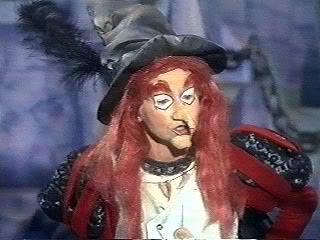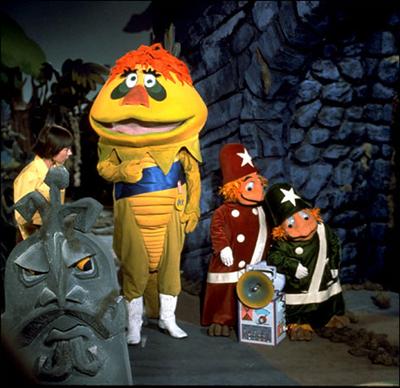Four Key Episodes – “H.R. Pufnstuf”
By Robert R. Garver
Bob Garver here with my fourth column for F.A.N. This week I take a look at the epitome of the trippy kids’ show.
What I know going in: I’ve heard stories. Created by Sid and Marty Krofft in the late 1960s, “H.R. Pufnstuf” is supposedly a kids show with bright colors and strange creatures. The show is best remembered in association with the illegal drugs of the 60s. I’ve heard from various sources that the creators were on drugs, the characters were on drugs, the show promoted drug use, etc. Though the Krofft brothers deny any drug connotations, many are quick to point out evidence to the contrary.
Was the show influenced by more than imagination? Is it a decent show if you’re not stoned? Let’s find out.
First Episode – “The Magic Path”
Plot: Human boy Jimmy tries to take Freddie, his magical flute, on a boat trip. The evil Witchiepoo tries to crash the boat so she can steal Freddie for herself. Jimmy is rescued by H.R. Pufnstuf, friendly mayor of nearby Living Island. Pufnstuf is a big yellow being and absolutely everything on Living Island is alive. The two new friends concoct a plan to get Jimmy home again.
Thoughts: The main character makes an enemy of a witch and winds up in a weird world where the trees talk. Not exactly an original plot. The show’s theme song goes on forever. I usually don’t like it when shows go to commercial right after the title sequence, but on this show the opening is almost as long as a proper first act. The sets and puppets are all incredibly cheap-looking, but it’s all part of the show’s charm. Pufnstuf is pretty charming himself, and I wish he was on a better show. The humor is atrocious. Example: Jimmy and Pufnstuf go to see a scientist named Dr. Blinky who’s an owl. Being an owl, Dr. Blinky often makes a “Hoo” sound. The other characters think he’s asking “Who?” and there is much confusion. I have to watch three more episodes with these kinds of jokes.
I didn’t pick up on any drug references other than a tree with a personality like a hippie stereotype. What I wasn’t prepared for was his companion, a tree with a personality like an Indian (Native American) stereotype. I didn’t know so much cultural insensitivity could be packed into the space of about five seconds. The stereotypically Asian East Wind isn’t much better.
Rating: One and a Half Stars out of Five.
Second Episode – “The Wheely Bird”
Plot: Freddie tries to sacrifice himself to Witchiepoo, thinking that she’ll leave Jimmy and Pufnstuf alone if he does. But Jimmy and Pufnstuf aren’t about to leave their friend behind. They use Dr. Blinky’s new Wheely Bird vehicle as a Trojan Horse to gain entry to Witchiepoo’s castle and rescue Freddie.
Thoughts: Many of the jokes used in the first episode (including the “Hoo”/”Who?” bit) are repeated here, and they’re somehow even less funny the second time around. It looks like the show is out of ideas early. Although it is a little funny to see Witchiepoo’s bird guard fall in love with the wooden Wheely Bird, as well as get a lump on his head that looks suspiciously like a slowly-inflating balloon.
Rating: One and a Half Stars out of Five.

In the 1990s, adolescent males had the Pink Power Ranger to fantasize about. In the '70s, we had...this.
Middle Episode – “The Birthday Party”
Plot: It’s Jimmy’s birthday and he’s feeling homesick. Pufnstuf decides to throw him a surprise party. Witchiepoo and her henchmen invade the party disguised as a band. Knocking everybody out with laughing gas, she steals Freddie. Orson the bird henchman ends up knocking himself out and passes out in a bowl of red candy. After coming to, Jimmy and Pufnstuf formulate a plan to get Freddie back by playing the candy stuck to Orson’s face as a contagious disease.
Thoughts. It’s a great episode for about the first two thirds. Every kid should have a party like this. The jokes are better (the “Hoo/”Who?” bit is mercifully gone) and there’s a loveable musical number where Jimmy executes some scary-good dance moves. Even Witchiepoo and her henchmen are in rare form as they disguise themselves as hip musical group The Three Lemons. It’s the kind of fun atmosphere that defines the show.
Then the episode takes a turn for the worse as they have to invade Witchiepoo’s castle. The “Red-spotitis” scenes move like molasses, aren’t funny, and worst of all take the story away from the wonderful party.
On a side note, Witchiepoo knocks everyone out with “laughing gas”, a smoke that makes everybody laugh at everything and not care about what else is going on. I’m not saying it’s a marijuana reference, I’m just saying it’s a good piece of evidence if you want to make a case for drug references in the show.
Rating: Three Stars out of Five
Final Episode – “Jimmy Who?”
Plot: Witchiepoo casts a spell on Jimmy that gives him amnesia. Pufnstuf, Freddie and others try to jog his memory through flashbacks. Uncomfortable around his own friends, Jimmy runs off and finds Witchiepoo, who tries to jog his memory herself with flashbacks (she made the amnesia spell too powerful and now he can’t remember where Freddie is). Pufnstuf arrives to save the day.
Thoughts: The episode features old clips (even they’re new to me, it’s still lazy filler), an amnesia storyline, and the unwelcome return of the “Hoo/Who?” jokes. It’s a trifecta of suckiness.
Rating: Zero stars out of Five.
Final Thoughts: I get the impression that “H.R. Pufnstuf” hit its stride somewhere in the middle. It was probably a struggle just to get the first few episodes made, and the show was out of good ideas at the end, but the middle seems like it gave the Krofft brothers a chance to play around creatively. But from what I’ve seen, the show is mostly candy-colored crap. Pufnstuf himself is endearing, but most of the other characters are either annoying or one-note (with Freddie I only mean that figuratively). The Krofft brothers may deny that they made the show on drugs, but they may want to say that they were just so they have an excuse for why the show is so frigging awful.
Robert Garver is a graduate of the Cinema Studies program at New York University. Check out his movie review blog at www.bobatthemovies.com. He welcomes feedback, criticisms, and suggestions for future columns at rrg251@nyu.edu.

